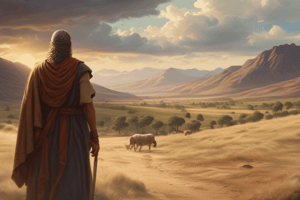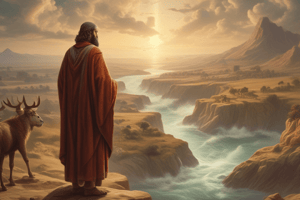Podcast
Questions and Answers
The Babylonian Captivity began in 587 b.c.
The Babylonian Captivity began in 587 b.c.
False (B)
Ezra is presented as a godly and patriotic Jew who was a king.
Ezra is presented as a godly and patriotic Jew who was a king.
False (B)
Cyrus permits the Jews to return in 535 b.c.
Cyrus permits the Jews to return in 535 b.c.
False (B)
The temple is completed and dedicated in 520.
The temple is completed and dedicated in 520.
Ezra travels to Jerusalem in 458 b.c.
Ezra travels to Jerusalem in 458 b.c.
Ezra led the first group of Jews back to Jerusalem.
Ezra led the first group of Jews back to Jerusalem.
Nehemiah was a priest.
Nehemiah was a priest.
Zerubbabel was in the royal line of David.
Zerubbabel was in the royal line of David.
Cyrus's decree was dated 445 B.C.
Cyrus's decree was dated 445 B.C.
All twelve tribes of Israel were represented in the remnant.
All twelve tribes of Israel were represented in the remnant.
The Jews who returned from Babylon continued to live in Babylon.
The Jews who returned from Babylon continued to live in Babylon.
Elijah set up the altar again in Babylon.
Elijah set up the altar again in Babylon.
The Samaritans were a half-breed nation of mixed Jews and Gentiles.
The Samaritans were a half-breed nation of mixed Jews and Gentiles.
The temple was completed and dedicated in 520.
The temple was completed and dedicated in 520.
The Word of God had begun the work in Babylon.
The Word of God had begun the work in Babylon.
Haggai has four different messages in his book.
Haggai has four different messages in his book.
Zechariah's book deals with a different period of time from Haggai's book.
Zechariah's book deals with a different period of time from Haggai's book.
Nehemiah was the cupbearer to the king.
Nehemiah was the cupbearer to the king.
Nehemiah's brother brought him good news about Jerusalem.
Nehemiah's brother brought him good news about Jerusalem.
Nehemiah prayed for four days after hearing the news about Jerusalem.
Nehemiah prayed for four days after hearing the news about Jerusalem.
Nehemiah had a plan in his mind to rebuild the walls of Jerusalem.
Nehemiah had a plan in his mind to rebuild the walls of Jerusalem.
Nehemiah was a servant when he arrived at the city.
Nehemiah was a servant when he arrived at the city.
Nehemiah believed in a one-man ministry.
Nehemiah believed in a one-man ministry.
The work of rebuilding the walls was organized and directed by the spiritual leaders.
The work of rebuilding the walls was organized and directed by the spiritual leaders.
The sheep gate had locks and bars.
The sheep gate had locks and bars.
The valley gate is the first gate mentioned in the passage.
The valley gate is the first gate mentioned in the passage.
The dung gate is a symbol of the cleansing of our lives.
The dung gate is a symbol of the cleansing of our lives.
The horse gate is a symbol of the second coming of Jesus Christ.
The horse gate is a symbol of the second coming of Jesus Christ.
The gate of the fountain represents the Word of God.
The gate of the fountain represents the Word of God.
The Miphkad gate is a symbol of God's judgment.
The Miphkad gate is a symbol of God's judgment.
Flashcards are hidden until you start studying
Study Notes
Introduction to Ezra and Nehemiah
- The books of Ezra and Nehemiah form one book in the Hebrew Bible, telling the story of the return of the remnant to Jerusalem and the rebuilding of the city and the temple.
- The Babylonian Captivity began in 606 B.C. and lasted for 70 years, as predicted by Jeremiah (Jer. 25:12-14; 29:10-14).
- The period of captivity is marked by the deportation of Jews, including Daniel and Ezekiel, and the eventual return of the remnant to Jerusalem.
Chronology of the Period
- 606-605 B.C.: Babylon begins invading and deporting Jews.
- 587 B.C.: Jerusalem falls to the enemy.
- 539 B.C.: Babylon falls to Cyrus and the Media-Persian empire begins.
- 538 B.C.: Cyrus permits the Jews to return to Jerusalem.
- 535 B.C.: The Jews begin to rebuild the temple, but the work stops.
- 520 B.C.: The work begins again, and the temple is completed and dedicated in 515 B.C.
- 476 B.C.: Esther becomes Queen of Persia.
- 458 B.C.: Ezra travels to Jerusalem.
The Leaders
- Ezra:
- A godly and patriotic Jew.
- A priest and a scribe.
- Devoted student of the Scriptures.
- Helped to restore the Law to the nation.
- A man of prayer.
- Led a second group of Jews back to Jerusalem.
- Nehemiah:
- An officer in the king's court.
- A layman with no prophetic call or priestly lineage.
- Promoted to governor.
- Zerubbabel:
- A leader under Ezra.
- Also called Sheshbazzar.
- Official title was "tirshatha", meaning "governor".
- Part of the royal line of David.
- Served as the political leader of the restored nation.
- Joshua:
- The high priest at the time.
- Mentioned in Ezra 3:2, Haggai 1:1, 12, 14, and Zechariah 3:1-10.
The Lessons
- God fulfilled His promise of captivity, but also promised that a remnant would return.
- The captivity cured the Jews of idolatry and gave them a desire to know and obey the Word.
- The Jews forgot their lessons quickly, and the book of Ezra and Nehemiah serves as a reminder of God's faithfulness.
Ezra 1-5
- The return to the land (Ezra 1-2):
- Cyrus's decree to return and rebuild the temple.
- The precious things, including the temple treasures, were restored to the Jews.
- The people, including priests, Levites, and other groups, returned to Jerusalem.
- Rebuilding the temple (Ezra 3):
- Establishing the altar.
- Laying the foundation of the temple.
- The people rejoiced and sang, but older people wept, remembering the former temple.
- Resisting the enemy (Ezra 4):
- The people of the land, including Samaritans, opposed the Jews' work.
- Zerubbabel and Joshua refused their aid.
- The work ceased for 15 years due to opposition.
- Resuming the work (Ezra 5):
- The Word of God was proclaimed by Haggai and Zechariah.
- The work began again, and the temple was completed and dedicated.
Nehemiah 1-3
- Nehemiah prays for the work (Nehemiah 1):
- The report of Jerusalem's state.
- Nehemiah's response, including fasting and praying.
- His request for God's favor and protection.
- Nehemiah prepares for the work (Nehemiah 2):
- Approaching the king.
- The king's favor and provision for the work.
- Nehemiah's investigation of the city's state.
- Nehemiah prospers in the work (Nehemiah 3):
- The pattern of organization and cooperation.
- The people, including spiritual leaders, rulers, and women, worked together.
- The gates of Jerusalem, including the sheep gate, fish gate, old gate, and others, were repaired.
Studying That Suits You
Use AI to generate personalized quizzes and flashcards to suit your learning preferences.




